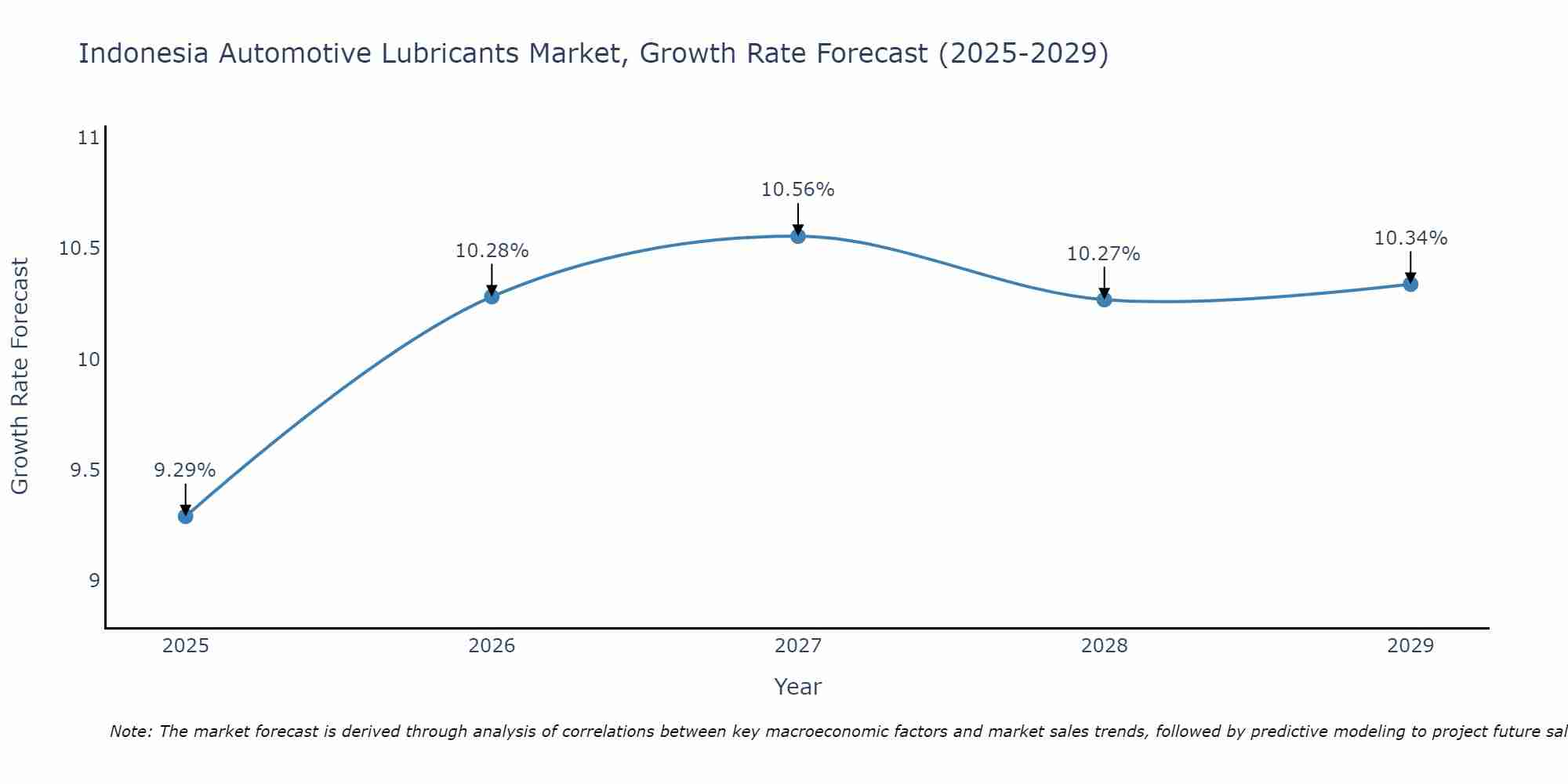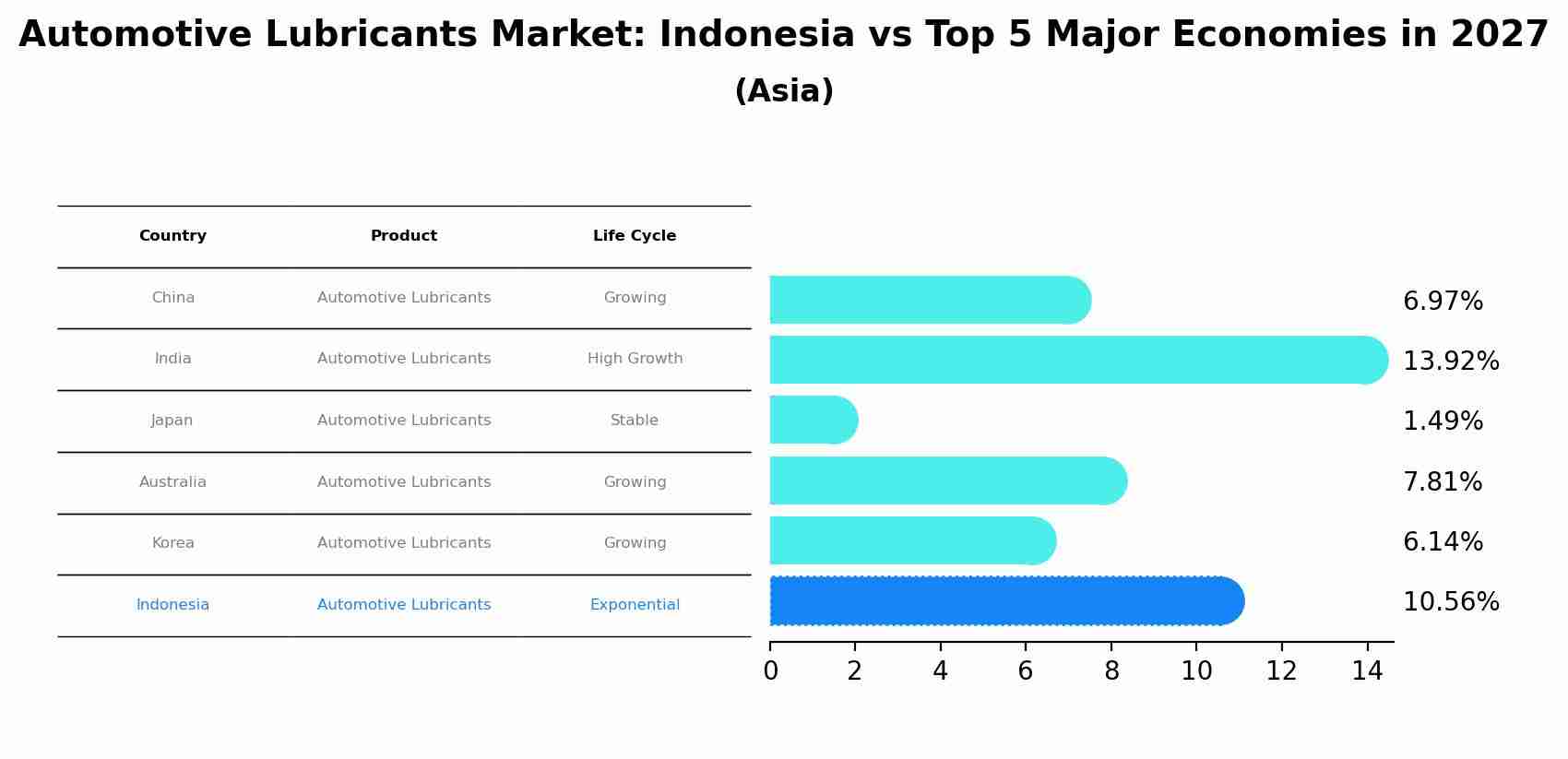Indonesia Automotive Lubricants Market | Revenue, Analysis, Industry, COVID-19 IMPACT, Outlook, Growth, Share, Size, Forecast, Value, Companies & Trends
| Product Code: ETC172187 | Publication Date: Jul 2023 | Updated Date: Aug 2025 | Product Type: Market Research Report | |
| Publisher: 6Wresearch | No. of Pages: 70 | No. of Figures: 35 | No. of Tables: 5 | |
Indonesia Automotive Lubricants Market Size Growth Rate
The Indonesia Automotive Lubricants Market is projected to witness mixed growth rate patterns during 2025 to 2029. The growth rate begins at 9.29% in 2025, climbs to a high of 10.56% in 2027, and moderates to 10.34% by 2029.

Automotive Lubricants Market: Indonesia vs Top 5 Major Economies in 2027 (Asia)
The Automotive Lubricants market in Indonesia is projected to grow at a high growth rate of 10.56% by 2027, highlighting the country's increasing focus on advanced technologies within the Asia region, where China holds the dominant position, followed closely by India, Japan, Australia and South Korea, shaping overall regional demand.

Indonesia Automotive Lubricants MarketSynopsis
The Indonesia lubricants market is currently estimated to be worth approximately US$ 1.8 billion in 2020 and is projected to grow at a CAGR of 4.9% during the forecast period (2020-2025). The growth can be attributed to factors such as increasing vehicle production, government initiatives for clean fuel vehicles, technological advancements in engine lubricants, and rising demand from commercial vehicles and two-wheelers.
Market Trends
In recent years synthetic lubricants have gained popularity owing their better performance when compared with mineral oils primarily due to their ability to reduce friction inside engines and prevent wear & tear caused by metal surfaces coming into contact with each other while operating under high temperatures & pressures. With rising environmental concerns over traditional petroleum based lubricants various biodegradable alternatives are increasingly gaining traction among automotive users mainly due its properties which make it safe for use around water bodies hence reducing pollution levels significantly making them ideal substitutes for conventional oils. Advancement within automation technology has enabled automakers integrate robotic system that can apply precise amounts oil directly onto moving components thereby eliminating any human errors ensuring greater efficiency during production process resulting higher cost savings.
Market Drivers
Over the past few years there have been significant investments towards development of infrastructure projects across Indonesia which has resulted rapid expansion vehicle fleet size across major cities powering demand automotive lubes further aided reduced import tariffs imposed by local governments providing additional boost exports sector.
COVID-19 Impact on the Market
The COVID-19 pandemic has had a significant impact on the automotive lubricants market in Indonesia. The disruption of supply chains, decrease in industrial production and reduced consumer spending have all contributed to an overall decline in demand for automotive lubricants across the country. Additionally, the implementation of social distancing measures by local governments has further impacted sales volumes due to lower levels of car usage.
Challenges of the Market
Moreover, growing concerns over health and safety among consumers are driving them towards more environment-friendly products such as synthetic motor oils or bio-based ones. This shift is likely to pose a challenge for traditional players operating with mineral oil based products as they will need to invest heavily into research and development activities or risk losing their customers.
Industry Key Players
Some key players operating within the Indonesia Automotive Lubricants Market include ExxonMobil, Shell Oil Company, PT Pertamina Lubrindo, Chevron Corporation & Total SA. These companies offer a wide range of conventional and premium grade lubricants designed for different types of vehicles such as passenger cars, commercial trucks etc.,
Key Highlights of the Report:
- Indonesia Automotive Lubricants Market Outlook
- Market Size of Indonesia Automotive Lubricants Market, 2023
- Forecast of Indonesia Automotive Lubricants Market, 2030
- Historical Data and Forecast of Indonesia Automotive Lubricants Revenues & Volume for the Period 2020-2030
- Indonesia Automotive Lubricants Market Trend Evolution
- Indonesia Automotive Lubricants Market Drivers and Challenges
- Indonesia Automotive Lubricants Price Trends
- Indonesia Automotive Lubricants Porter's Five Forces
- Indonesia Automotive Lubricants Industry Life Cycle
- Historical Data and Forecast of Indonesia Automotive Lubricants Market Revenues & Volume By Product Type for the Period 2020-2030
- Historical Data and Forecast of Indonesia Automotive Lubricants Market Revenues & Volume By Engine Oil for the Period 2020-2030
- Historical Data and Forecast of Indonesia Automotive Lubricants Market Revenues & Volume By Gear Oil for the Period 2020-2030
- Historical Data and Forecast of Indonesia Automotive Lubricants Market Revenues & Volume By Transmission Fluids for the Period 2020-2030
- Historical Data and Forecast of Indonesia Automotive Lubricants Market Revenues & Volume By Brake Fluids for the Period 2020-2030
- Historical Data and Forecast of Indonesia Automotive Lubricants Market Revenues & Volume By Coolants for the Period 2020-2030
- Historical Data and Forecast of Indonesia Automotive Lubricants Market Revenues & Volume By Greases for the Period 2020-2030
- Historical Data and Forecast of Indonesia Automotive Lubricants Market Revenues & Volume By Vehicle Type for the Period 2020-2030
- Historical Data and Forecast of Indonesia Automotive Lubricants Market Revenues & Volume By Passenger Vehicles for the Period 2020-2030
- Historical Data and Forecast of Indonesia Automotive Lubricants Market Revenues & Volume By Commercial Vehicles for the Period 2020-2030
- Historical Data and Forecast of Indonesia Automotive Lubricants Market Revenues & Volume By Motorcycles for the Period 2020-2030
- Indonesia Automotive Lubricants Import Export Trade Statistics
- Market Opportunity Assessment By Product Type
- Market Opportunity Assessment By Vehicle Type
- Indonesia Automotive Lubricants Top Companies Market Share
- Indonesia Automotive Lubricants Competitive Benchmarking By Technical and Operational Parameters
- Indonesia Automotive Lubricants Company Profiles
- Indonesia Automotive Lubricants Key Strategic Recommendations
Frequently Asked Questions About the Market Study (FAQs):
1 Executive Summary |
2 Introduction |
2.1 Key Highlights of the Report |
2.2 Report Description |
2.3 Market Scope & Segmentation |
2.4 Research Methodology |
2.5 Assumptions |
3 Indonesia Automotive Lubricants Market Overview |
3.1 Indonesia Country Macro Economic Indicators |
3.2 Indonesia Automotive Lubricants Market Revenues & Volume, 2020 & 2030F |
3.3 Indonesia Automotive Lubricants Market - Industry Life Cycle |
3.4 Indonesia Automotive Lubricants Market - Porter's Five Forces |
3.5 Indonesia Automotive Lubricants Market Revenues & Volume Share, By Product Type, 2020 & 2030F |
3.6 Indonesia Automotive Lubricants Market Revenues & Volume Share, By Vehicle Type, 2020 & 2030F |
4 Indonesia Automotive Lubricants Market Dynamics |
4.1 Impact Analysis |
4.2 Market Drivers |
4.2.1 Growth in the automotive industry in Indonesia |
4.2.2 Increasing vehicle ownership and usage rates |
4.2.3 Technological advancements in lubricant products |
4.2.4 Demand for fuel-efficient lubricants |
4.2.5 Government regulations promoting the use of high-quality lubricants |
4.3 Market Restraints |
4.3.1 Fluctuating raw material prices |
4.3.2 Competition from counterfeit or low-quality lubricants |
4.3.3 Environmental concerns regarding lubricant disposal |
4.3.4 Impact of economic conditions on consumer spending |
4.3.5 Lack of awareness about the benefits of premium lubricants |
5 Indonesia Automotive Lubricants Market Trends |
6 Indonesia Automotive Lubricants Market, By Types |
6.1 Indonesia Automotive Lubricants Market, By Product Type |
6.1.1 Overview and Analysis |
6.1.2 Indonesia Automotive Lubricants Market Revenues & Volume, By Product Type, 2020-2030F |
6.1.3 Indonesia Automotive Lubricants Market Revenues & Volume, By Engine Oil, 2020-2030F |
6.1.4 Indonesia Automotive Lubricants Market Revenues & Volume, By Gear Oil, 2020-2030F |
6.1.5 Indonesia Automotive Lubricants Market Revenues & Volume, By Transmission Fluids, 2020-2030F |
6.1.6 Indonesia Automotive Lubricants Market Revenues & Volume, By Brake Fluids, 2020-2030F |
6.1.7 Indonesia Automotive Lubricants Market Revenues & Volume, By Coolants, 2020-2030F |
6.1.8 Indonesia Automotive Lubricants Market Revenues & Volume, By Greases, 2020-2030F |
6.2 Indonesia Automotive Lubricants Market, By Vehicle Type |
6.2.1 Overview and Analysis |
6.2.2 Indonesia Automotive Lubricants Market Revenues & Volume, By Passenger Vehicles, 2020-2030F |
6.2.3 Indonesia Automotive Lubricants Market Revenues & Volume, By Commercial Vehicles, 2020-2030F |
6.2.4 Indonesia Automotive Lubricants Market Revenues & Volume, By Motorcycles, 2020-2030F |
7 Indonesia Automotive Lubricants Market Import-Export Trade Statistics |
7.1 Indonesia Automotive Lubricants Market Export to Major Countries |
7.2 Indonesia Automotive Lubricants Market Imports from Major Countries |
8 Indonesia Automotive Lubricants Market Key Performance Indicators |
8.1 Average age of vehicles in Indonesia |
8.2 Adoption rate of synthetic lubricants |
8.3 Number of automotive workshops offering premium lubricant services |
8.4 Frequency of vehicle maintenance services |
8.5 Environmental impact assessment of lubricant products |
9 Indonesia Automotive Lubricants Market - Opportunity Assessment |
9.1 Indonesia Automotive Lubricants Market Opportunity Assessment, By Product Type, 2020 & 2030F |
9.2 Indonesia Automotive Lubricants Market Opportunity Assessment, By Vehicle Type, 2020 & 2030F |
10 Indonesia Automotive Lubricants Market - Competitive Landscape |
10.1 Indonesia Automotive Lubricants Market Revenue Share, By Companies, 2023 |
10.2 Indonesia Automotive Lubricants Market Competitive Benchmarking, By Operating and Technical Parameters |
11 Company Profiles |
12 Recommendations |
13 Disclaimer |
- Single User License$ 1,995
- Department License$ 2,400
- Site License$ 3,120
- Global License$ 3,795
Search
Related Reports
- UAE Building Thermal Insulation Market Outlook (2025-2031) | Revenue, Companies, Share, Trends, Growth, Size, Forecast, Industry, Analysis & Value
- Portugal Electronic Document Management Market (2025-2031) | Strategy, Consumer Insights, Analysis, Investment Trends, Opportunities, Growth, Size, Share, Industry, Revenue, Segments, Value, Segmentation, Supply, Forecast, Restraints, Outlook, Competition, Drivers, Trends, Demand, Pricing Analysis, Competitive, Strategic Insights, Companies, Challenges
- France Electronic Document Management Market (2025-2031) | Strategy, Consumer Insights, Analysis, Investment Trends, Opportunities, Growth, Size, Share, Industry, Revenue, Segments, Value, Segmentation, Supply, Forecast, Restraints, Outlook, Competition, Drivers, Trends, Demand, Pricing Analysis, Competitive, Strategic Insights, Companies, Challenges
- Portugal Occupational Health & Safety Services Market (2025-2031) | Strategy, Consumer Insights, Analysis, Investment Trends, Opportunities, Growth, Size, Share, Industry, Revenue, Segments, Value, Segmentation, Supply, Forecast, Restraints, Outlook, Competition, Drivers, Trends, Demand, Pricing Analysis, Competitive, Strategic Insights, Companies, Challenges
- Netherlands Occupational Health and Safety Services Market (2025-2031) | Strategy, Consumer Insights, Analysis, Investment Trends, Opportunities, Growth, Size, Share, Industry, Revenue, Segments, Value, Segmentation, Supply, Forecast, Restraints, Outlook, Competition, Drivers, Trends, Demand, Pricing Analysis, Competitive, Strategic Insights, Companies, Challenges
- Belgium and Luxembourg Facility Management Market (2025-2031) | Strategy, Consumer Insights, Analysis, Investment Trends, Opportunities, Growth, Size, Share, Industry, Revenue, Segments, Value, Segmentation, Supply, Forecast, Restraints, Outlook, Competition, Drivers, Trends, Demand, Pricing Analysis, Competitive, Strategic Insights, Companies, Challenges
- Russia Women Intimate Apparel Market (2025-2031) | Strategy, Consumer Insights, Analysis, Investment Trends, Opportunities, Growth, Size, Share, Industry, Revenue, Segments, Value, Segmentation, Supply, Forecast, Restraints, Outlook, Competition, Drivers, Trends, Demand, Pricing Analysis, Competitive, Strategic Insights, Companies, Challenges
- Africa Chocolate Market (2025-2031) | Size, Share, Trends, Growth, Revenue, Analysis, Forecast, industry & Outlook
- Global Hydroxychloroquine And Chloroquine Market (2025-2031) | Industry, Trends, Size, Outlook, Growth, Value, Companies, Revenue, Analysis, Share, Forecast
- Saudi Arabia Plant Maintenance Market (2025-2031) | Industry, Size, Growth, Revenue, Value, Companies, Forecast, Analysis, Share & Trends
Industry Events and Analyst Meet
Our Clients
Whitepaper
- Middle East & Africa Commercial Security Market Click here to view more.
- Middle East & Africa Fire Safety Systems & Equipment Market Click here to view more.
- GCC Drone Market Click here to view more.
- Middle East Lighting Fixture Market Click here to view more.
- GCC Physical & Perimeter Security Market Click here to view more.
6WResearch In News
- Doha a strategic location for EV manufacturing hub: IPA Qatar
- Demand for luxury TVs surging in the GCC, says Samsung
- Empowering Growth: The Thriving Journey of Bangladesh’s Cable Industry
- Demand for luxury TVs surging in the GCC, says Samsung
- Video call with a traditional healer? Once unthinkable, it’s now common in South Africa
- Intelligent Buildings To Smooth GCC’s Path To Net Zero













